MEMORIES AND RECOLLECTIONS OF THE EARLY YEARS AT THE VE
By ERICH NEUKIRCHNER
This story of the VE is from personal recollections and the recollections of many other old timers who were teenagers at the start of the club. Our older brothers and sisters wanted to write something down, but never got around to do so. They are no longer with us. If we don’t write of the wonderful and interesting days at the VE it will be forgotten. These things I want to mention about the history of the Club. The name Verienigung Erzgebirge was suggested by Albein Reichel, and was adopted by the board members. The name of thee property, Waldesrauchen (Whispering Woods) was suggested by Erich Haase and adopted by the board members. The logo of the Club, three pine trees on three little hills with the letters V.E. in white under the trees, was taken from the logo of the town of Thalheim/Erzgebirge and was adopted by the board members.
ORIGINAL CLUB HOUSE AND CANTEEN
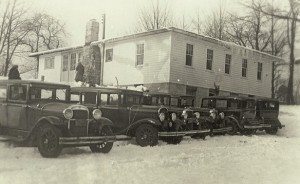 The property had a house (where the cell phone tower currently stands), which stood on the western edge of the 32-acre plot by County Line road, which became our first clubhouse. There was also an old garage or barn about 50 yards east of the big bungalow with a road leading to County Line Road. An addition was built on to the big bungalow including a bar downstairs and a parking lot. A path led down the hill from the rear of the parking lot to bridge over the creek. It was a footbridge, just two logs with boards nailed on top. From the bridge a path went to the right alongside the creek and led to a picnic area. Another path led from the bridge alongside of an open field to the picnic area. A canteen was constructed in the picnic area. The canteen had three open sides and a brick kitchen attached to it. The sides were of peeled logs. A bar was in the center of the canteen. This was fine in nice weather, but when it rained or was cold many people left for home and revenue was lost. In 1938 a new enclosed and enlarged canteen was built. The picnic tables were also constructed at that time. The tabletops and seats were removable and could be stored inside the canteen during the winter. Hot food was served on Saturdays and Sundays in the big bungalow during the fall, winter, and spring. In summer the Big Bungalow was closed and the canteen was opened. A water line was put in from County Line Road to provide water for the kitchen and bar in the canteen. Two outdoor fireplaces were constructed near the canteen to cook the food. Another fireplace with a large kettle for heating water and washing dishes was constructed. Both used wood for heating. An outhouse was constructed about 40 yards from the cante and used until the brick canteen was built many years later. All the ladies took turns washing the dishes and doing other kitchen chores, as well as cleaning the outhouse. When the big bungalow was closed in the summer we boys were permitted to sleep there over the weekend. Everyone had a cot or sleeping bag or blankets. Sunday morning we went to the picnic area and took rakes and cleaned up the area. The club fed us breakfast. When County Line road was widened the big bungalow was demolished. The big oak tree that once stood next to the big bungalow also had to be removed for the widening of the road. The big oak was determined to be one of the oldest in Bucks County. In 1960 the wooden canteen burned to the ground. We were again fortunate because previous to the fire we had a lot of rain and the surrounding woods did not catch on fire. A new canteen was built in 1961 and it had indoor bathrooms and modern automatic dishwashing facilities inside the kitchen. The aromatic outhouse was demolished and filled in. Another larger bridge was built near the old footbridge, strong enough to carry vehicles, The retaining walls for this bridge are still very solid today. One time we had a heavy rain during the weekend and the creek rushed under the footbridge and almost washed it away. We teenagers stood on the footbridge watching the water rush underneath. Fred Schubert went up stream a little and bank were he was standing gave way and Fred was washed into the water. We tried to get him out of the water by the bridge but he washed under. We ran downstream and made a human chain and pulled Fred out of the water. We got a very quick lesson about the power of water.
The property had a house (where the cell phone tower currently stands), which stood on the western edge of the 32-acre plot by County Line road, which became our first clubhouse. There was also an old garage or barn about 50 yards east of the big bungalow with a road leading to County Line Road. An addition was built on to the big bungalow including a bar downstairs and a parking lot. A path led down the hill from the rear of the parking lot to bridge over the creek. It was a footbridge, just two logs with boards nailed on top. From the bridge a path went to the right alongside the creek and led to a picnic area. Another path led from the bridge alongside of an open field to the picnic area. A canteen was constructed in the picnic area. The canteen had three open sides and a brick kitchen attached to it. The sides were of peeled logs. A bar was in the center of the canteen. This was fine in nice weather, but when it rained or was cold many people left for home and revenue was lost. In 1938 a new enclosed and enlarged canteen was built. The picnic tables were also constructed at that time. The tabletops and seats were removable and could be stored inside the canteen during the winter. Hot food was served on Saturdays and Sundays in the big bungalow during the fall, winter, and spring. In summer the Big Bungalow was closed and the canteen was opened. A water line was put in from County Line Road to provide water for the kitchen and bar in the canteen. Two outdoor fireplaces were constructed near the canteen to cook the food. Another fireplace with a large kettle for heating water and washing dishes was constructed. Both used wood for heating. An outhouse was constructed about 40 yards from the cante and used until the brick canteen was built many years later. All the ladies took turns washing the dishes and doing other kitchen chores, as well as cleaning the outhouse. When the big bungalow was closed in the summer we boys were permitted to sleep there over the weekend. Everyone had a cot or sleeping bag or blankets. Sunday morning we went to the picnic area and took rakes and cleaned up the area. The club fed us breakfast. When County Line road was widened the big bungalow was demolished. The big oak tree that once stood next to the big bungalow also had to be removed for the widening of the road. The big oak was determined to be one of the oldest in Bucks County. In 1960 the wooden canteen burned to the ground. We were again fortunate because previous to the fire we had a lot of rain and the surrounding woods did not catch on fire. A new canteen was built in 1961 and it had indoor bathrooms and modern automatic dishwashing facilities inside the kitchen. The aromatic outhouse was demolished and filled in. Another larger bridge was built near the old footbridge, strong enough to carry vehicles, The retaining walls for this bridge are still very solid today. One time we had a heavy rain during the weekend and the creek rushed under the footbridge and almost washed it away. We teenagers stood on the footbridge watching the water rush underneath. Fred Schubert went up stream a little and bank were he was standing gave way and Fred was washed into the water. We tried to get him out of the water by the bridge but he washed under. We ran downstream and made a human chain and pulled Fred out of the water. We got a very quick lesson about the power of water.
THE POOL
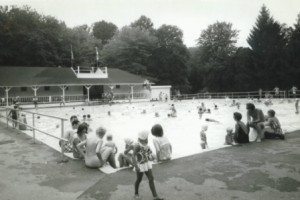 About 50 yards in from County Line Road the creek was dammed up to make a swimming hole. The water was about three feet deep. It was cold and shady and only a few brave or foolish kids went in the water. Arno Vorwerk was instrumental in having a swimming pool built. This pool consisted of three concrete walls and a mud bottom. Just inside the club property, the creek was diverted into a sluice, which filled the pool. It took approximately two weeks to fill the pool. The following year the pool was cemented all around. A well was dug and the pool was filled in only two days. The pool had unpainted walls and bottom. In time algae built up and two or three times a season the pool had to be cleaned. About 3 o’clock in the afternoon of cleaning day the pool was closed and drained. The pool was scrubbed by hand. The cleaning crew just kept circling the pool using scrub brushes and brooms. We never had a shortage of workers. The pool was kept sanitary by putting chlorine into the water and the water was tested using a kit. During a heavy rain the entire pool was underwater. The creek was only about ten yards from the pool and made a sharp “S” turn. The water backed up during a heavy rainstorm and would flood out the pool. This turn was straightened out and extended from the pool and the pool never flooded out again. Having a public pool meant having lifeguards. All interested men and boys were given rudimentary life saving lessons. A duty list was posted and followed. We even had a lifeguard who couldn’t swim!
About 50 yards in from County Line Road the creek was dammed up to make a swimming hole. The water was about three feet deep. It was cold and shady and only a few brave or foolish kids went in the water. Arno Vorwerk was instrumental in having a swimming pool built. This pool consisted of three concrete walls and a mud bottom. Just inside the club property, the creek was diverted into a sluice, which filled the pool. It took approximately two weeks to fill the pool. The following year the pool was cemented all around. A well was dug and the pool was filled in only two days. The pool had unpainted walls and bottom. In time algae built up and two or three times a season the pool had to be cleaned. About 3 o’clock in the afternoon of cleaning day the pool was closed and drained. The pool was scrubbed by hand. The cleaning crew just kept circling the pool using scrub brushes and brooms. We never had a shortage of workers. The pool was kept sanitary by putting chlorine into the water and the water was tested using a kit. During a heavy rain the entire pool was underwater. The creek was only about ten yards from the pool and made a sharp “S” turn. The water backed up during a heavy rainstorm and would flood out the pool. This turn was straightened out and extended from the pool and the pool never flooded out again. Having a public pool meant having lifeguards. All interested men and boys were given rudimentary life saving lessons. A duty list was posted and followed. We even had a lifeguard who couldn’t swim!
THE WAR YEARS
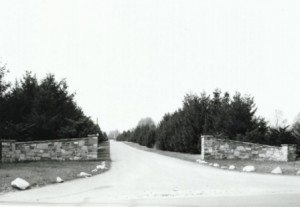 Gas was rationed during the war. Some members took the Fox chase line to County Line and walked the mile to the club. Gas ration cards were donated and redistributed to club members so that they could drive to the club and open and close the place. On Sunday afternoons County Line road was full of hikers and baby strollers all walking to catch the last train back to the city. A few bottles of beer went to the train crew. We had enough train cars for tall the people and no one was left behind. The new entrance to the club was on Davisville road. Two nice stonewalls were built to enhance the entrance. The long straight drive way was planted with three rows of pine trees on each side. The end of the long drive brought you to a large parking lot. The new clubhouse was built in 1956. A new soccer field and fistball field were installed next to the clubhouse. Going back a few years to the late 30’s the specter of Nazism was spreading. Most of our members were not in favor of this new Germany. We were a sport club and not a political club. At one festival a family whose son carried a dirigible balloon with a swastika on the tail was asked to put the balloon in the trunk of the car or leave the property. Many of the members served in the military and a plague was installed in the Ratskeller that commemorated their service to the United States. Some Navy Fliers from Willow Grove Air Station were given club and pool privileges. In return the club received some beautiful aerial photos of the club and grounds. After World War II many German scientists were stationed at Johnsville Air Station and the VE was the only German Club that they were permitted to visit.
Gas was rationed during the war. Some members took the Fox chase line to County Line and walked the mile to the club. Gas ration cards were donated and redistributed to club members so that they could drive to the club and open and close the place. On Sunday afternoons County Line road was full of hikers and baby strollers all walking to catch the last train back to the city. A few bottles of beer went to the train crew. We had enough train cars for tall the people and no one was left behind. The new entrance to the club was on Davisville road. Two nice stonewalls were built to enhance the entrance. The long straight drive way was planted with three rows of pine trees on each side. The end of the long drive brought you to a large parking lot. The new clubhouse was built in 1956. A new soccer field and fistball field were installed next to the clubhouse. Going back a few years to the late 30’s the specter of Nazism was spreading. Most of our members were not in favor of this new Germany. We were a sport club and not a political club. At one festival a family whose son carried a dirigible balloon with a swastika on the tail was asked to put the balloon in the trunk of the car or leave the property. Many of the members served in the military and a plague was installed in the Ratskeller that commemorated their service to the United States. Some Navy Fliers from Willow Grove Air Station were given club and pool privileges. In return the club received some beautiful aerial photos of the club and grounds. After World War II many German scientists were stationed at Johnsville Air Station and the VE was the only German Club that they were permitted to visit.
THE COTTAGES
A section of the club was set aside for plots of ground approximately 30 by 60 feet. Each member could have one to use at no charge. The members were obligated to keep it attractive. Most had tables and chairs. Mr. Krenkle was the first to build a cottage and many more were built in the 1940’s. The cottages were listed as overnight cottages and were not taxable. A well was dug and an outhouse was built. The well was tested every year and many members spent their weekends in the cottages. Some retired members would spend the whole summer in the cottages.
KARNAVOL
In February of every year a Prince and Princess are chosen. The players wear medieval jesters hats. The show includes rowdy humor and complaints about the hard times. People from other German clubs come to be entertained. We even had visitors from Baltimore.
VOGELSHIESSEN
This was a day especially for the ladies. A large wooden figure of a two-headed German eagle was bolted on a backboard. The eagle was about seven feet tall and four feet wide. A bar at the top of the backboard held a rope with a weighted metal dart, which was used to “shoot” at the eagle. The ladies would pull back the rope and let it fly to knock down the eagle. On this day the ladies did no work. The unmarried and young girls did the cooking, dish washing, and serving. As usual the day started with a parade and many ladies wore new dresses bought just for this occasion. Prizes were given to ladies that knocked off pieces of the eagle and the lady who knocked off the last piece was declared the queen for the year. The following year the Queen would be the first to shoot. The Queen and the club provided coffee, cake, and drinks for the day to all the other ladies. As with other events it lost its appeal and it is no longer held. The first Vogelschiessen was held in August 1934 and it continued to 1941. None were held again until 1950 due to the war. Vogelschiessen was held until 1973.
KINDERFEST
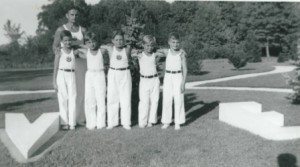 The yearly Kinderfest was always interesting. A parade started the festivities. The children were given a card with a string to be placed around their neck. Each event they participated in was punched in the card. Everyone received a hot dog and a soda. The most popular was the wire ride. A large tree next to the present day music stage held the upper end of the wire. A large tower stood at 12 feet high and the children would go down the 70-yard wire to a backstop where an old mattress would help them stop! An attendant would attach the pulley and lock the safety bar and another attendant would help catch the rider at the end of the wire. The youngster was required to carry the pulley back to next rider or they would not be allowed to ride it again. A chair was fashioned onto a pulley so that even the children under 6 could ride the wire. Listening to the squeals of absolute delight of the children made the extra work of the attendants worthwhile.
The yearly Kinderfest was always interesting. A parade started the festivities. The children were given a card with a string to be placed around their neck. Each event they participated in was punched in the card. Everyone received a hot dog and a soda. The most popular was the wire ride. A large tree next to the present day music stage held the upper end of the wire. A large tower stood at 12 feet high and the children would go down the 70-yard wire to a backstop where an old mattress would help them stop! An attendant would attach the pulley and lock the safety bar and another attendant would help catch the rider at the end of the wire. The youngster was required to carry the pulley back to next rider or they would not be allowed to ride it again. A chair was fashioned onto a pulley so that even the children under 6 could ride the wire. Listening to the squeals of absolute delight of the children made the extra work of the attendants worthwhile.
FISTBALL
The summer sport at the club was Fistball. The game is played like volleyball but with 5 players on a side and the ball is allowed to bounce. There is a string instead of a net and there are 3 forwards and two backs. The VE club was a member of the Eastern Fistball Association, which was founded in 1948, and included Phoenix and SSC of Flanders NJ. Fistball was played at the club until the mid 80s.
SPORTFEST
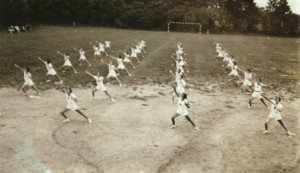 In the mid 30’s the four big German clubs got together to plan the big events for the month of September. It was decided that the Canstatter Club would have the Labor Day weekend; VE would have the next weekend, then the German Hungarians and finally the Bavarian club. The tradition continues to this day. Hans Roeder set up the exercise routine for the day. The day began with the parade of Sportlers. The men wore long white trousers and white sneakers with white muscle shirts. The VE emblem was sewn in the center of the shirt. The ladies wore white skirts and sneaks, white blouses and also the VE emblem sewn in the center of the blouse. Boys looked like the men but wore shorts instead.
In the mid 30’s the four big German clubs got together to plan the big events for the month of September. It was decided that the Canstatter Club would have the Labor Day weekend; VE would have the next weekend, then the German Hungarians and finally the Bavarian club. The tradition continues to this day. Hans Roeder set up the exercise routine for the day. The day began with the parade of Sportlers. The men wore long white trousers and white sneakers with white muscle shirts. The VE emblem was sewn in the center of the shirt. The ladies wore white skirts and sneaks, white blouses and also the VE emblem sewn in the center of the blouse. Boys looked like the men but wore shorts instead.
The girls wore the same outfits as the ladies. 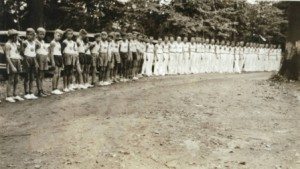 Practice for the exercises began in late July and everyone was required to attend. The same 3 or 4 boys always managed to avoid practice by hiding in the woods. At Sportsfest after the soccer game a fistball was played and then the exercise were done. Sportsfest is sill held today without the exercises. At the 1979 sportfest Captain Kenneth Parris landed his Army helicopter on the lawn of the clubhouse delivering the ball for the game.
Practice for the exercises began in late July and everyone was required to attend. The same 3 or 4 boys always managed to avoid practice by hiding in the woods. At Sportsfest after the soccer game a fistball was played and then the exercise were done. Sportsfest is sill held today without the exercises. At the 1979 sportfest Captain Kenneth Parris landed his Army helicopter on the lawn of the clubhouse delivering the ball for the game.
CHRISTMAS
Early in December each year a “Lichtel Abend” is held. People bring their Christmas objects to display. Old Christmas carols and songs are sung. It is very nice evening and sets the tone for the season. There is also a Christmas Party for the children.
INTERESTED IN READING MORE HISTORY ABOUT GERMANY, GERMAN-AMERICANS, PHILADELPHIA, AND THE VEREINIGUNG ERZGEBIRGE ????
Vereinigung Erzgebirge member and director Richard Thieme completed his Master of Arts Degree in History from La Salle University in 2010. His thesis “The Last Oktoberfest: German-Americans and the City of Brotherly Love” is a detailed account of many social organizations in the Greater Philadelphia Region. Click the following link to read this detailed account:
The Last Oktoberfest: German-Americans and the City of Brotherly Love
